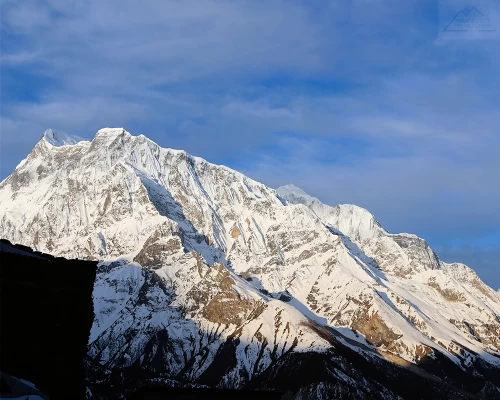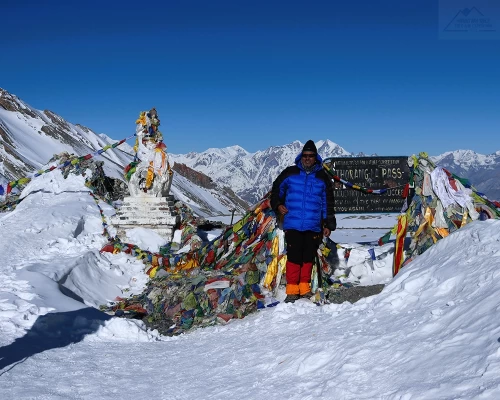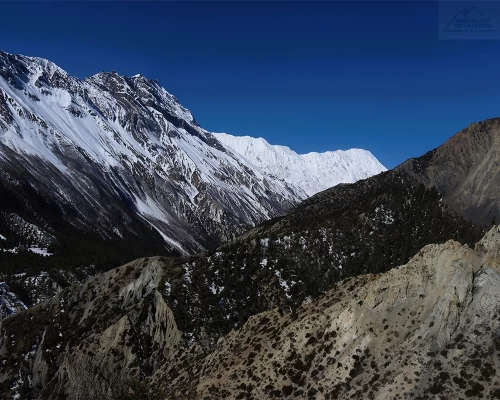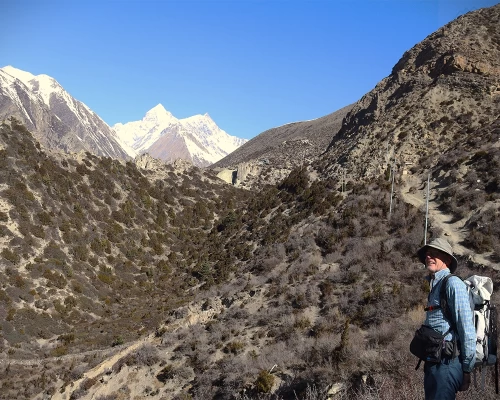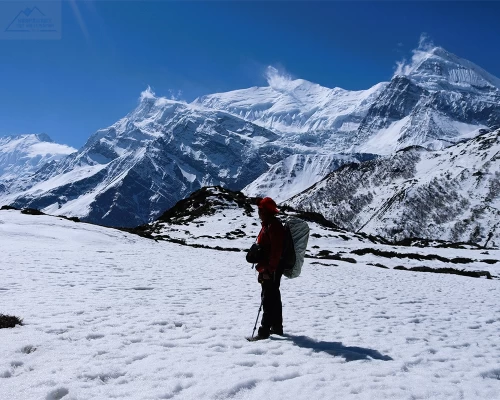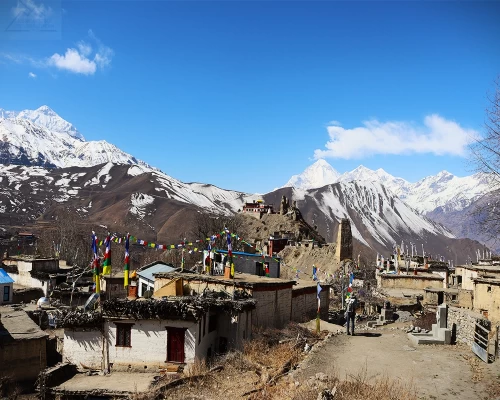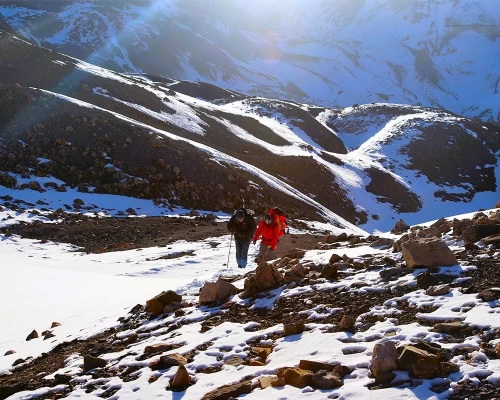Annapurna Circuit with Tilicho Lake Trek in Annapurna Region is one of the best experiences trekking in Nepal. The highest lake in the world is Tilicho Lake, which is 5200 meters high from sea level. This Trek around Annapurna brings a unique experience of Hindu and Buddhist cultures, the highest lake treks in Nepal, the widest pass trek in Nepal, the deepest gorge, delightful farming from low elevation to the high peak, the most expansive valley in Nepal and Annapurna views from the different angles. Annapurna circuit is a world-popular and best trekking route. Mountain Rock Treks has been organizing this 20 Day Annapurna Circuit Trek Linking Tilicho Lake for a long time. While trekking, you gain a different diversity of scenery, geography, people's living standards, climate, and trekking trail.
Annapurna Circuit trek with Tilicho Lake and Poon Hill Trek takes us to the world's highest lake in the Manang District of Nepal. This trek starts from Besisahar and follows the Marsyangdi River with great views of Manaslu and Him Chuli to the east. This magnificent route leads you through traditional Manangi villages inhabited by friendly, habitual people who always offer a warm welcome amidst the magical, snow-capped Himalayas. The first part of the Annapurna Circuit Trek with Tilicho Lake Itinerary Annapurna Circuit Trekking. However, from Manang, we go to the central valley to the west and trek up to Tilicho Lake. Tilicho Lake collects the ice melt of the surrounding mountains and glaciers, including Tilichio Peak and Tilichio Glaciers. It is one of the highest lakes in the world, with its surface being 4990m. In 2001, Hindu pilgrims worldwide flocked to the lake, convinced it was a holy spot mentioned in the Ramayan - a holy book of the Hindus.
Our Tilicho Lake trekking with Annapurna Circuit Trail again joins the Annapurna Circuit route and crosses the Thorong La pass, one of the highest passes in the world. We also climb up to Poon Hill, famous for its spectacular views of the Annapurna and Dhaulagiri ranges. On our 20-day Annapurna Tilicho Lake Trek, we pass through forests, cross pristine meadows, and experience the change in vegetation while being in the company of the glorious Himalayas.
Annapurna Circuit Trekking With Tilicho Lake Trek Major Highlights
- The Annapurna Circuit with Tilicho Lake Poon Hill Trek passes through lowland Brahmin and Chhetri villages to the remote village of Manang. Then, it descends to the Kali Gandaki Gorge (officially the deepest gorge in the world).
- Tilicho Lake is the highest lake globally and the main attraction of this trek.
- Thorung La Pass (5416m) in the trek is one of the highest passes in the world, which trekkers can summit without climbing a mountain.
- The Sunrise view from Poon Hill is another main attraction of this trek
- With a wide range of culturally rich ethnic groups and diverse terrain that ranges from subtropical jungle to high and dry landscape, the trek also includes spiritual hub Muktinath and Poon Hill, a famous viewpoint for panoramic mountain views.
- Tread and visit places like Manang, and Muktinath which are the epitomes of the lifestyles and culture.
- Get the glimpse of breath-taking Himalayan landscapes of Annapurna, Thorung Peak, Nilgiri, Chulu, Thukuche, Dhaulagiri, and others on Annapurna Circuit with Tilicho Lake Trek.
- This trail is supremely adventurous, a combination of cultural events and natural scenery of the Annapurna region that lasts for 20 days.
- Pay a visit to the Bhraga monastery and the Manang settlements.
What Annapurna Circuit and Tilicho Lake Trek Package Offers?
The 20-day Annapurna Circuit Trekking with Tilicho Lake is a great Himalayan adventure which you can join from Pokhara or Kathmandu. The package offers experienced guides, porters (who carry all of the gear), three meals, tea house accommodations per day, permits, etc.
Travelers get an opportunity to travel through the different habitats – from luscious green valleys enriched with flora and fauna to uphill paths with the unobstructed view of the Annapurna range to the main view of the Annapurna range. Walking to Tilicho Lake (4919m) can be hard at first, but it provides a fantastic view of the glacier from the top. here are more of what the package offers for the traveler below:
- A full-guided 20-day Annapurna Tilicho Lake Trek Itinerary, which will take you along the classic route and also will give you a chance to reach Tilicho Lake, the highest lake for its size in the world.
- Every meal during the trekking (from breakfast to dinner) and accommodations at the tea houses.
- The assistance crew consists of a native guide who will guide you on the route, porters who will carry the trekkers’ luggage, and an assistant guide on the Trekking in Annapurna Circuit Tilicho Lake package.
- Chance to take on the challenges of the high Himalayas alongside the stillness, calmness, and beauty of national parks in the form of varied landscape structures and cultural/geographical diversity.
- The privilege to accomplish the toughest trek, the Thorong-La Pass (5,416m), between the mountain ranges.
- With the package, you reach the best viewpoints all over the trekking distance. One of the best viewpoint destinations included in the package is Poonhill, where you see the panorama of Mt. Dhaulagiri and Annapurna peaks involve climbing up to Poon Hill.
Can a Beginner Join the Annapurna Circuit Trek with Tilicho Lake?
Even though the 20 Day Annapurna Circuit Trek Linking Tilicho Lake is recognized as challenging, beginners can still join it with some good preparation. The trek’s highest point is 5,416 meters, Thorong La Pass, which needs a well-equipped fitness level to traverse it. Here are some of the considerations to make before Joining this hike as a beginner:
- As a beginner, you should climb by stairs or hike smaller hills and do this for a few months before the trek. Ensure that you are sure you can handle a 5-6 hour walking level, including steep climbs and descents on Annapurna Circuit Trek connecting the Tilicho Lake route.
- Because the trek lasts almost 20 days, hikers with little or no hiking experience should be accompanied by a guide who knows the trail and porters to carry the heavy gear.
- Climbing slowly, keeping physically fit and hydrated, and not overdoing are crucial to hiking at high altitudes.
Best Annapurna Circuit Trekking and Tilicho Lake 20 Day Itinerary From Pokhara or Kathmandu
We at Mountain Rock Treks provide the best itinerary for Annapurna Circuit Tilicho trekking, which is carefully structured to ensure your security and happiness.
You can choose to start the trek in Kathmandu, the capital, or Pokhara, a lovely lakeside city cuddled between mountains. We know that our consumers differ in their expectations and requirements. For this, we offer a customized option on the trek packages that will be tailored to your level of fitness, interests, and traveling style.
Annapurna Circuit Trek Linking Tilicho Lake route takes us through magnificent yet challenging mountains. At Mountain Rock Treks, we place safety first by guiding you through proper acclimatization. An itinerary has been well planned with gradual elevation gains and rest days intentionally placed. We do so to reduce the risk of altitude sickness, enabling you to enjoy the unique Himalayan experience to the fullest.
Contact Mountain Rock Treks today and we'll work closely with you to customize your Annapurna Circuit trek itinerary, ensuring it aligns perfectly with your desires.
Is Annapurna Circuit Trek with Tilicho Lake Right for You?
- If you want a peaceful trekking experience rather than a crowded one like the Everest Base Camp trek, this 20-day hike is right for you. It draws fewer tourists and has a chance to interact with the local people along the journey.
- It's perfect for those with good fitness and can sustain a 5-6-hour trek under a moderate elevation without discomfort. For this, you are reasonably good at physical conditioning.
- Annapurna Circuit Trek combining Tilicho Lake may be the ideal trek for travelers who love the homey life in a mountain hut and long trailside walking. Provides a thrilling and memorable hike.
- Living among the locals allows you to explore culture —chatting with friendly locals and teahouse attendants, visiting ancient monasteries, and marveling at Buddhist stupas and mani stones. This is a great experience if you crave to learn about the local culture, way of life, etc.
- If you prefer luxury, then this Annapurna Tilicho Lake Trek 20 Day is not for you, as these remote places do not provide anything but basic accommodations.
- Not the best choice for persons who cannot withstand height and low pressure. It can be dangerous to hike to 17,769 ft, knowing that altitude sickness is a lurking risk.
- A trip perfect for people who are relatively fit and want to have incredible Himalayan views that will stretch around the Annapurna range during a course of 2-3 weeks.
Annapurna Circuit Trek with Tilicho Lake 2024 and 2025
The Annapurna Circuit Trek and Tilicho Lake costs range from $930 to $1,130 USD per person, depending on the group size. The cost includes all teahouse accommodations, breakfast, lunch, and dinner, an English-speaking knowledgeable guide, a professional porter to carry the bags, necessary permits, and fees.
The price of trekking in Annapurna Circuit Tilicho Lake fluctuates depending on the group's size. While participating in a group, the cost is divided among the number of participants. Here are the costs we offer for different no of people below:
No Of Pax | Cost Per Person | Status |
2-6 | $ 1130 | |
7-12 | $ 1009 | |
13-30 | $958 |

